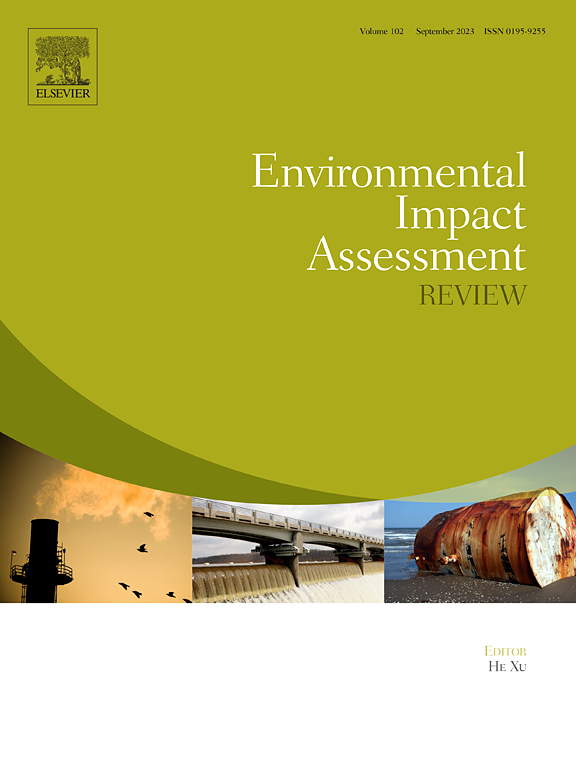Freshwater biodiversity risk exposure of Natura 2000 sites to industrial pollution
IF 11.2
1区 社会学
Q1 ENVIRONMENTAL STUDIES
引用次数: 0
Abstract
While every protected and conserved area can be exposed to pollution, some may suffer more. We develop methods to analyze their freshwater biodiversity risks from industrial sites around Europe. This study is novel as it is the first attempt at linking the European Pollutant Release and Transfer Register to the geographic data of Natura 2000 sites. Furthermore, we applied the improved characterization factors in the Environmental Footprint database published by the European Commission Joint Research Centre. The proximity of biggest industrial facilities to Natura 2000 sites, which is the largest network of protected areas in the world, can affect freshwater biodiversity risks in Europe and globally. We quantify hazards in the recent past and at the Natura 2000 site level. We find that European protected natural areas are exposed to more eutrophication and biodiversity risks mostly from the Sewerage and water treatment sector in the most industrialised European regions especially in the Benelux states, Southern Germany, in Northern Italy and South-West France. 370 of the E-PRTR facilities were located less than 500 m away from the border of Natura 2000 sites with protected freshwater species, 126 of which less than 100 m away and 51 within Natura 2000 sites. River basin districts of the Danube, Ebro and the Elbe were estimated to be most affected by pollutant releases with ecotoxicity and eutrophication impact potential in 2019. Approximately 3 % of industrial facilities reporting to the E-PRTR pollutant releases into water are closer to foreign Natura 2000 sites with freshwater fish or amphibian species than to the closest Natura 2000 site in the country where they are located. All this calls for improved monitoring and respective prevention measures in some key regions of Europe along with coordinated international biodiversity loss mitigation efforts.
淡水生物多样性风险暴露的自然2000点工业污染
虽然每个受保护的地区都可能受到污染,但有些地区可能会受到更严重的污染。我们开发了一些方法来分析欧洲各地工业基地的淡水生物多样性风险。这项研究是新颖的,因为它是第一次尝试将欧洲污染物释放和转移登记与Natura 2000站点的地理数据联系起来。此外,我们在欧盟委员会联合研究中心发布的环境足迹数据库中应用了改进的表征因子。Natura 2000是世界上最大的保护区网络,最大的工业设施靠近自然保护区,可能会影响欧洲和全球淡水生物多样性的风险。我们量化了最近和Natura 2000站点级别的危害。我们发现欧洲自然保护区域接触更多的富营养化和生物多样性的风险主要来自污水和水处理行业最发达的欧洲地区尤其是在比荷卢州,德国南部,意大利北部和法国西南部。370 E-PRTR设施位于不到500米的距离自然2000个站点的边境保护淡水物种,其中126不到100米,51在自然2000网站。据估计,2019年多瑙河、埃布罗河和易北河流域地区受具有生态毒性和富营养化影响潜力的污染物排放影响最大。在向E-PRTR报告污染物排放到水中的工业设施中,约有3%更接近有淡水鱼或两栖动物物种的外国Natura 2000站点,而不是它们所在国家最近的Natura 2000站点。所有这些都要求在欧洲一些关键区域改进监测和相应的预防措施,同时协调国际上减轻生物多样性丧失的努力。
本文章由计算机程序翻译,如有差异,请以英文原文为准。
求助全文
约1分钟内获得全文
求助全文
来源期刊

Environmental Impact Assessment Review
ENVIRONMENTAL STUDIES-
CiteScore
12.60
自引率
10.10%
发文量
200
审稿时长
33 days
期刊介绍:
Environmental Impact Assessment Review is an interdisciplinary journal that serves a global audience of practitioners, policymakers, and academics involved in assessing the environmental impact of policies, projects, processes, and products. The journal focuses on innovative theory and practice in environmental impact assessment (EIA). Papers are expected to present innovative ideas, be topical, and coherent. The journal emphasizes concepts, methods, techniques, approaches, and systems related to EIA theory and practice.
 求助内容:
求助内容: 应助结果提醒方式:
应助结果提醒方式:


